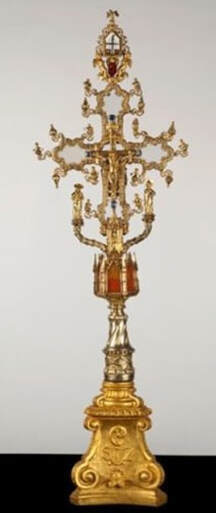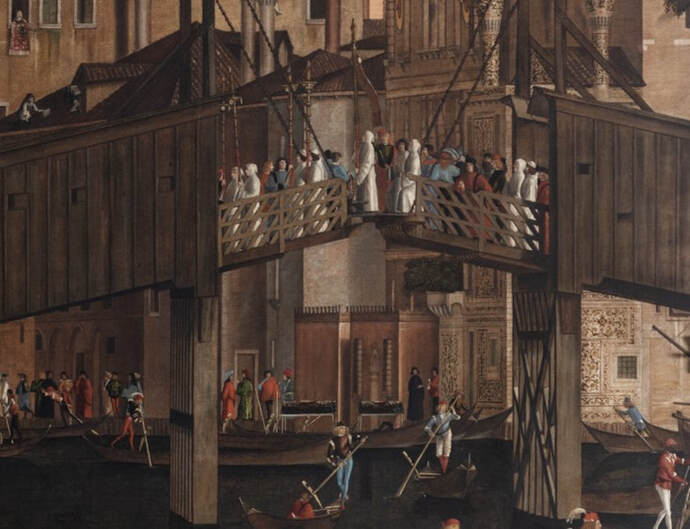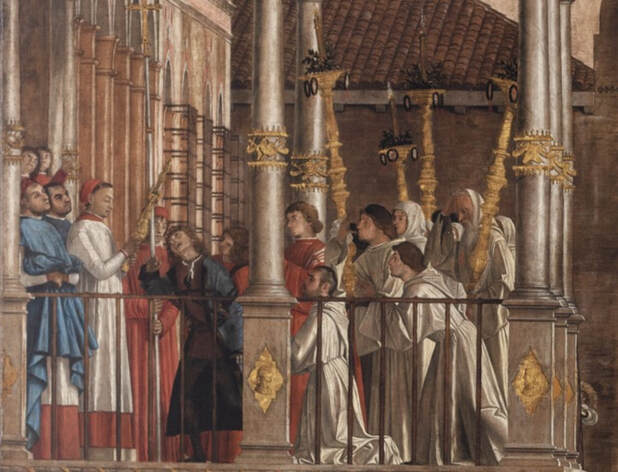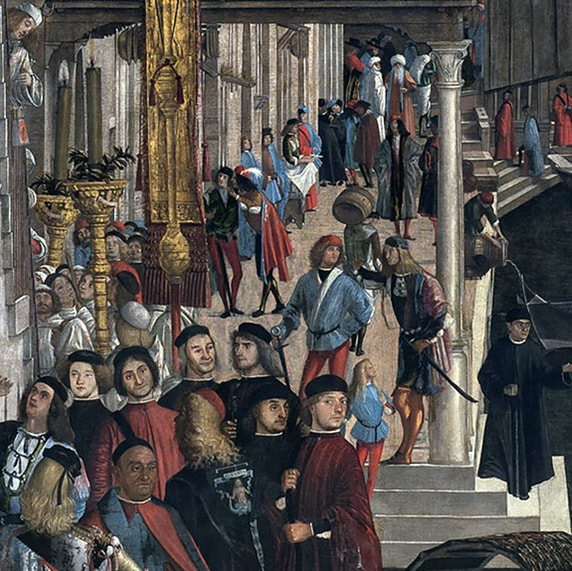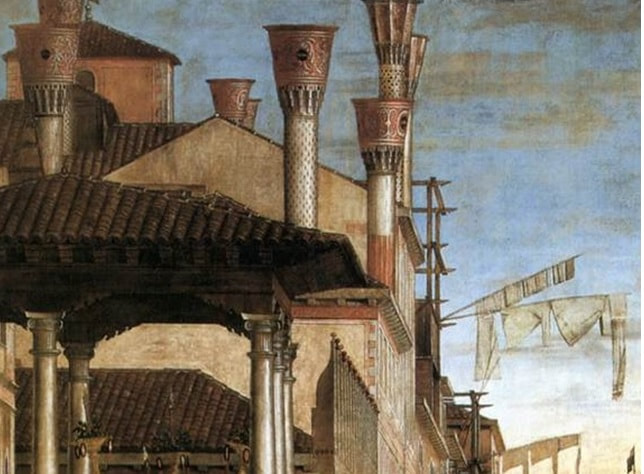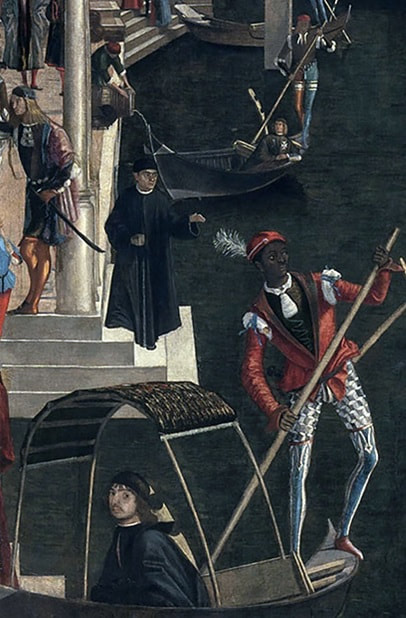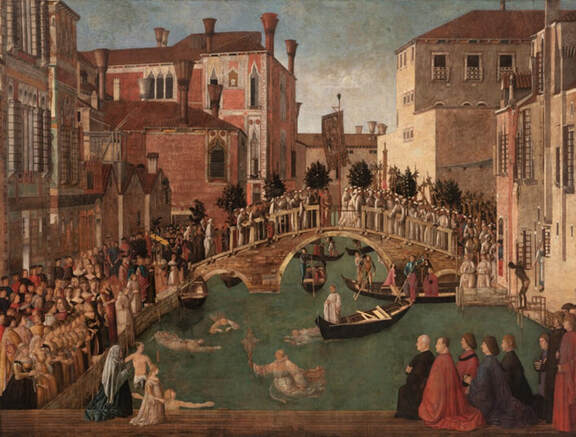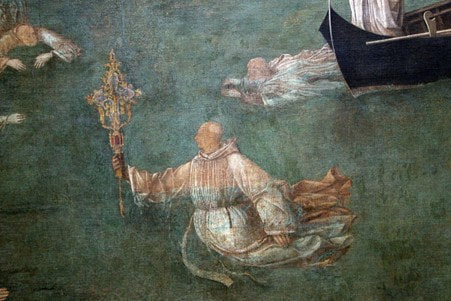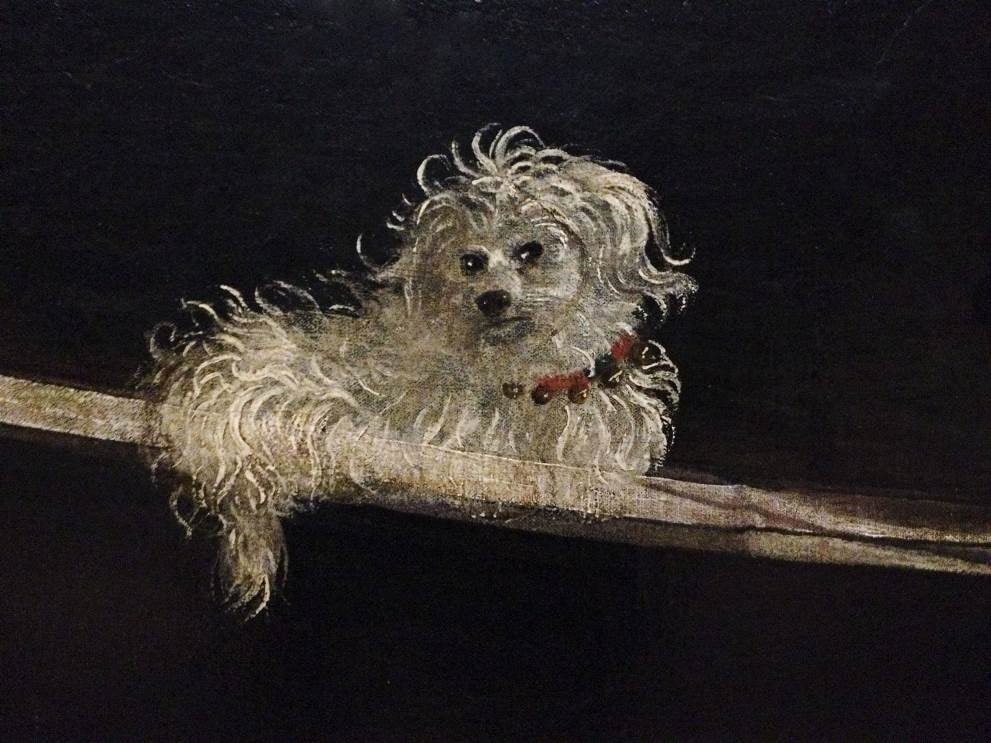Carpaccio's Miracle on the Rialto
By Philip McCouat For reader comments on this article see here
Introduction
It’s not often that a fully-fledged miracle is upstaged by a fluffy dog. Or that slaves are dressed better than their masters. Or that an exorcism is conducted using a splinter. But these things happen in the 15th century Venice which is depicted by Vittore Carpaccio in his famous Miracle of the Relic of the True Cross at the Rialto Bridge.
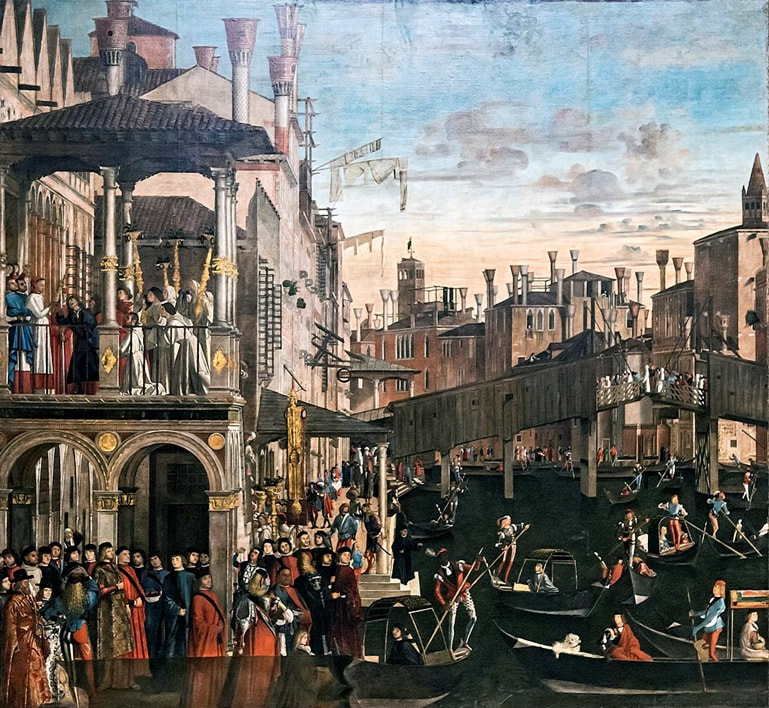 Fig 1: Vittore Carpaccio, The Miracle of the Relic [of the True Cross] at the Rialto Bridge (also known as The Healing of the Possessed Man at Rialto, or The Healing of the Madman (1495), 3.65m x 3.89m, Gallerie dell’Accadamia, Venice
Fig 1: Vittore Carpaccio, The Miracle of the Relic [of the True Cross] at the Rialto Bridge (also known as The Healing of the Possessed Man at Rialto, or The Healing of the Madman (1495), 3.65m x 3.89m, Gallerie dell’Accadamia, Venice
Carpaccio was the ultimate chronicler of life in early Renaissance Venice. We actually don’t know very much about him, though it seems that his family name was Scarpazza, that he was associated with Gentile Bellini, and that he grew up and lived in Venice all his life. Essentially, he is known mainly through his paintings [1].
This particular painting is huge, as it was designed to fill a wall. It depicts the cure of a possessed boy, brought about by the miraculous healing powers of a wood splinter fragment from the “True Cross”. Interestingly, this pivotal incident is actually tucked away on the extreme left, with the rest of the painting being dedicated to portraying the busy cosmopolitan life of Venice. So, as the first step in exploring the painting, we must first acquaint ourselves with the exceptional role that Venice was playing at the time.
This particular painting is huge, as it was designed to fill a wall. It depicts the cure of a possessed boy, brought about by the miraculous healing powers of a wood splinter fragment from the “True Cross”. Interestingly, this pivotal incident is actually tucked away on the extreme left, with the rest of the painting being dedicated to portraying the busy cosmopolitan life of Venice. So, as the first step in exploring the painting, we must first acquaint ourselves with the exceptional role that Venice was playing at the time.
Venice at the crossroads of power – and decline
In the 15th century, Venice was a bustling port city and a hugely important trading power. Situated at the European end of the Silk Road trading routes, it was in an ideal position to dominate trade between Europe and Asia, and this was reinforced by the commercial energy of its inhabitants and a canny military strategy that took advantage of its powerful navy and its protective island status.
Venice became a (relatively) multicultural mixing pot, attracting people from many countries, ranging from merchants and diplomats to slaves, with all the benefits -- and drawbacks -- that this entailed. It is perhaps no accident that, a century later, Shakespeare would choose Venice as the setting for two of his dramatic plays that deal with the conflicts and tensions affecting two members of minorities, a Jew (in the Merchant of Venice) and a black African ‘Moor’ (in Othello).
In 1495, however, when Carpaccio did this painting, he would have had little inkling that the seeds of Venice’s gradual decline had already been sown, or were soon to occur. While the reasons for this decline are complex, two of the major factors were the fall of Constantinople to a rival expansionist Ottoman Turkish empire in 1453, and Vasco de Gama’s 1499 discovery of a sea route to Asia via the Cape of Good Hope, thus bypassing the Mediterranean, which had been the centre of Venice’s power and influence.
Venice became a (relatively) multicultural mixing pot, attracting people from many countries, ranging from merchants and diplomats to slaves, with all the benefits -- and drawbacks -- that this entailed. It is perhaps no accident that, a century later, Shakespeare would choose Venice as the setting for two of his dramatic plays that deal with the conflicts and tensions affecting two members of minorities, a Jew (in the Merchant of Venice) and a black African ‘Moor’ (in Othello).
In 1495, however, when Carpaccio did this painting, he would have had little inkling that the seeds of Venice’s gradual decline had already been sown, or were soon to occur. While the reasons for this decline are complex, two of the major factors were the fall of Constantinople to a rival expansionist Ottoman Turkish empire in 1453, and Vasco de Gama’s 1499 discovery of a sea route to Asia via the Cape of Good Hope, thus bypassing the Mediterranean, which had been the centre of Venice’s power and influence.
The miracle, the possessed boy and the splinter
The miraculous True Cross splinter had been donated in 1369 to the charitable Scuola Grande di San Giovanni Evangelista, a charitable Christian Brotherhood which had been founded in Venice a century earlier. Fragments such as this were surprisingly common -- the 16th century French theologian John Calvin once sceptically observed, with only some degree of exaggeration, that if all the extant fragments of the Cross were put together, they would fill a large ship.
The Brotherhood eventually housed the fragment in a reliquary consisting of small crystal caplet gilded cross, and both fragment and reliquary still exist today [2].
The Brotherhood eventually housed the fragment in a reliquary consisting of small crystal caplet gilded cross, and both fragment and reliquary still exist today [2].
|
Over the years, the relic became associated with many miracles, and in 1494 the Brotherhood decided to commemorate these by commissioning a cycle of very large narrative paintings [3]. These were to be executed primarily by the renowned artist Gentile Bellini, but with some works being done by his possible pupil Carpaccio, who was already experienced in such projects, and other distinguished painters. The completed cycle was originally used to decorate the boardroom of the Scuola, but you can now see it in a dedicated room at Venice’s Gallerie dell’Accademia [4].
Carpaccio’s Miracle painting was part of this cycle. The miraculous exorcism that it depicts took place in full view of the public in about 1370, shortly after the splinter had arrived in Venice, at the Ca’ del Papa, the palazzo of the Patriarchs of Grado. As we can see from the painting, this palazzo was on the banks of the Grand Canal (which appears very dark in the painting [5]), in the district called the Rialto, which was Venice’s central business and religious area [6]. |
According to the traditional account of the miracle, there was a “possessed” boy in Venice whose relatives had tried everything to deliver him from his demons, but had failed. One day the family begged the Patriarch [7] to perform an exorcism. The Patriarch said that by himself he did not have such powers, and suggested they arrange to have the relic, which he venerated greatly, to be brought to him at the Ca’ del Papa in the hope that it could effect a miraculous cure. Sure enough, as soon as the Patriarch showed the boy the relic, the boy was instantly cured [8].
How Carpaccio depicts the miracle
In his painting, Carpaccio depicts two stages of the miraculous event taking place simultaneously, forming a continuous narrative. On the right-hand side of the painting, Carpaccio depicts the first stage, the initial procession of white clad members of the Scuola, who are responsible for transporting the reliquary, as they cross over the wooden Rialto Bridge. In Carpaccio’s time, this was the only bridge connecting the two sides of the Grand Canal, and it had a row of shops separated in the middle with a moveable boardwalk which could be raised to allow the passage of taller vessels [9].
On the left side of the painting, Carpaccio depicts the later stage in which the actual miracle takes place. Here the Cross splinter is now with the red-hatted Patriarch, on the upper level of the colonnaded balcony of the Ca’ del Papa. He is holding up the reliquary containing the fragment to the boy, who reels back, one arm raised, as the exorcism takes effect, and various Scuola members look on.
This is not the only way in which Carpacccio plays with time. Although the miracle occurred more than a century before, Carpaccio depicts the scene as if it were happening in the Venice of his own time. At ground level, below the balcony, various Venetian dignitaries clothed in red or black are gathered and, along the canal-side pathway (Riva del Vin) we can see a cross-section of busy Venetian life, with shopkeepers, errand boys, noblemen, Armenian traders, fashionable young men with long curly hair and colourful tights [10] and, near the bridge, two Turkish or Arabic turbaned merchants [11]. Carpaccio has also even included the circular sign of the Locanda della Sturion (Sturgeon Inn), which today is a stylish private hotel, the last remaining of the 24 historic inns established in the 13th century [12].
High above all this activity, our eyes are drawn to the numerous chimneys, with their distinctive funnel shapes (largely dictated by fashion reasons), reaching up to the sky. The buildings themselves are jammed together, reflecting the limitations of space on such a well-populated island. Those limitations also meant that Venetians normally had no garden spaces. Instead, some Venetians had roof terraces where they could enjoy the fresh air, and washing was hung out to dry on long poles, shown in the painting as protruding from the buildings [13].
Gondolas and slaves
Most of the action in Carpaccio’s painting takes place on the dark waters of the Grand Canal, where more than a dozen gondoliers, standing on the stern of their crafts, are transporting wealthy Venetians to and fro. We can see a mooring station for the boats in the background, beyond the bridge (Fig 3).
The most prominent gondolier, in the forefront of the painting, is dark-skinned, as is another directly beyond him in the background. Exotically dressed (perhaps because it is a feast day or festival, but in any event far outdoing his wealthy passenger), and with a jaunty feather in his cap, he is likely to be a slave or freed slave [14]. It seems that some freed slaves commonly worked as ferrymen crossing the canal [15], sometimes reaching quite prominent positions and high status in the ferrymen’s guilds.
The most prominent gondolier, in the forefront of the painting, is dark-skinned, as is another directly beyond him in the background. Exotically dressed (perhaps because it is a feast day or festival, but in any event far outdoing his wealthy passenger), and with a jaunty feather in his cap, he is likely to be a slave or freed slave [14]. It seems that some freed slaves commonly worked as ferrymen crossing the canal [15], sometimes reaching quite prominent positions and high status in the ferrymen’s guilds.
Slavery was well established in Venice. A young, teenaged healthy boy would cost about 50 ducats, about the same as an “untouched” healthy woman, with men costing more [16]. Most came from north or west Africa, often collectively referred to as Moors, and to a lesser extent, various countries in eastern Mediterranean countries. Black Africans in Venice were identified in various ways, according to skin colour, supposed geographical origin or religion. These descriptions, which were often used interchangeably (and inaccurately), included “saraceni,” which mostly indicated Arabs or Muslims from the region of Maghreb in North Africa or the Ottoman area; as “ethiops”; as “mori,” the Italian word for “dark,”; or as “neri” or “negri” meaning “blacks” [17].
Slaves were usually used for domestic service, which in canal-riddled Venice included being a private gondolier, the equivalent of being a coachman or groom in a household elsewhere [18]. Slaves from coastal backgrounds may well have had superior water skills and may have been particularly suited to water-based occupations [19]. It is interesting that in a companion painting by Bellini, discussed later in this article (Fig 8), there is a detail on the right, of a black African dressed only in a loincloth who appears to be about to dive into the canal.
On purchase, slaves were typically renamed and bound to their owners unconditionally. However, it was normal for them to be freed or provided for on the death of their master, or on completion of a specified number of years’ service [20]. For example, the master’s will might provide that they be continued in the service of his widow for a certain time, then be released with a legacy, or be provided with a job at the ferry station.
Slaves were usually used for domestic service, which in canal-riddled Venice included being a private gondolier, the equivalent of being a coachman or groom in a household elsewhere [18]. Slaves from coastal backgrounds may well have had superior water skills and may have been particularly suited to water-based occupations [19]. It is interesting that in a companion painting by Bellini, discussed later in this article (Fig 8), there is a detail on the right, of a black African dressed only in a loincloth who appears to be about to dive into the canal.
On purchase, slaves were typically renamed and bound to their owners unconditionally. However, it was normal for them to be freed or provided for on the death of their master, or on completion of a specified number of years’ service [20]. For example, the master’s will might provide that they be continued in the service of his widow for a certain time, then be released with a legacy, or be provided with a job at the ferry station.
A painting of the miracle, or of Venice?
It is interesting to contrast Carpaccio’s painting with one of Gentile Bellini’s paintings included in the cycle, which presents a version of another miraculous incident involving the same relic [21]. This is Bellini’s Recovery of the Relic at the Bridge of San Lorenzo (1500), painted a few years after Carpaccio’s work.
It depicts an occasion when the celebrated splinter somehow fell into the canal during a procession over the Bridge of San Lorenzo, but was miraculously located by the leader of the Brotherhood who had thrown himself into the water and emerged triumphantly holding it [22].
In his depiction Bellini uses muted colours and places the miraculous discovery in the front and centre of the painting, the sole item of attention for the crowded but orderly witnesses, who are showing respectful reverence.
In contrast, Carpaccio uses a selectively vibrant palette and, as we have seen, relegates the actual miracle to an inconspicuous place on the top left, with the vast majority of the painting devoted to the city and its citizens as they appeared in his own time – with many engaged in their own business on the footpath or on the canal, paying little attention to the miracle. So, for example, we can see a woman, totally oblivious (or uncaring) to what is happening, beating a rug at her window (Fig 3), a workman emptying his barrel into the canal and, in the central position corresponding to where Bellini depicts the miraculous discovery, Carpaccio carefully depicts a curly-haired small dog, who engagingly looks out at the viewer from its perch in the gondola. It is just one of the many dogs and other animals that Carpaccio was fond of including in his paintings, no matter what the context [23].
In contrast, Carpaccio uses a selectively vibrant palette and, as we have seen, relegates the actual miracle to an inconspicuous place on the top left, with the vast majority of the painting devoted to the city and its citizens as they appeared in his own time – with many engaged in their own business on the footpath or on the canal, paying little attention to the miracle. So, for example, we can see a woman, totally oblivious (or uncaring) to what is happening, beating a rug at her window (Fig 3), a workman emptying his barrel into the canal and, in the central position corresponding to where Bellini depicts the miraculous discovery, Carpaccio carefully depicts a curly-haired small dog, who engagingly looks out at the viewer from its perch in the gondola. It is just one of the many dogs and other animals that Carpaccio was fond of including in his paintings, no matter what the context [23].
Thus, while Bellini’s work is of a traditional miracle in an almost subsidiary city, Carpaccio treats his own work as more a painting of current city life -- with a high degree of accuracy [24], though in a slightly idealised and flattering way – and it is the miracle that is almost subsidiary.
Conclusion
Carpaccio is not overly concerned with Renaissance concepts of beauty or classical ideals, nor with excessive displays of piety. Rather, his attraction stems from his powers of observation, and his presentation of how things actually were. The 19th century critic John Ruskin once described Carpaccio as having an intense enjoyment of all visible things around him, and that his work was “a kind of magic mirror which flashes back instantly whatever it sees” [25]. If his painting has stirred your interest in historical Venice, or slavery, or the role of miracles, or the importance of the homely detail, his task is done.
© Philip McCouat 2022; first published July 2022
This article may be cited as Philip McCouat, "Carpaccio’s Miracle at the Rialto”, Journal of Art in Society, July 2022.
For another article on Carpaccio’s works, see Carpaccio’s Double Enigma
Return to HOME
© Philip McCouat 2022; first published July 2022
This article may be cited as Philip McCouat, "Carpaccio’s Miracle at the Rialto”, Journal of Art in Society, July 2022.
For another article on Carpaccio’s works, see Carpaccio’s Double Enigma
Return to HOME
End Notes
[1] For the linking of his name with the modern culinary dish known as carpaccio, see our article Carpaccio’s Double Enigma
[2] Save Venice blog, https://www.savevenice.org/project/reliquary-of-the-true-cross
[3] There were a number of similar Brotherhoods in Venice at this time, and they commonly commissioned artists in this way: John T. Paoletti and Gary M. Radke, Art in Renaissance Italy, Pearson Education. London, 2002 at 270-79
[4] Save Venice blog, https://www.savevenice.org/project/gentile-bellinis-miracle-of-the-relic-of-the-true-cross-at-the-bridge-of-san-lorenzo
[5] Possibly the colour is affected by discolouration: a thorough conservation is now being carried out: Save Venice blog, https://www.savevenice.org/project/miracle-of-the-reliquary-of-the-cross-at-the-rialto-bridge
[6] Venice was governed from the separate district of San Marco, with the Doge’s palace on St Mark’s Square
[7] Bishop Francesco Querini
[8] Save Venice blog: https://www.savevenice.org/project/miracle-of-the-reliquary-of-the-cross-at-the-rialto-bridge
[9] The bridge was actually rotting at this time, and later collapsed: Rose-Marie and Rainer Hagen, “The Merchants of Venice”, in What Great Paintings Say, Vol 1, Taschen, Koln at 102. The current version dates from 1591
[10] Matteo Casini, “The Company of the Hose: Youth and Courtly Culture in Europe, Italy and Venice’, Renaissance Studies, Republic of Venice, Studi Veneziani, LX11-LXIV (2011)
[11] Save Venice blog: https://www.savevenice.org/project/miracle-of-the-reliquary-of-the-cross-at-the-rialto-bridge
[12] Antica Locanda Sturion https://www.locandasturion.com/
[13] Hagen, op cit at 100
[14] Dark-skinned gondoliers also appear in Carpaccio’s Hunting on the Lagoon: see our article Carpaccio’s Double Enigma
[15] Kate Lowe, “Visible Lives: Black Gondoliers and Other Black Africans in Renaissance Venice.” Renaissance Quarterly, 66, 2, 2013, at 429 onwards
[16] Hagen, op cit at 103
[17] Lowe, op cit at 415 onwards
[18] Lowe, op cit at 421
[19] Lowe, op cit at 437
[20] Lowe, op cit at 421; Hagen, op cit at 103
[21] Augusto Gentile, “Painting in Venice”, in Venice: Art and Architecture (ed: Giandomenico Romanelli), Könemann, Cologne, 1997 at 275-6
[22] Patricia Fortini Brown, “An Incunabulum of the Miracles of the True Cross of the Scuola Grande di San Giovanni Evangelista” https://www.academia.edu/1069590/An_Incunabulum_of_the_Miracles_of_the_True_Cross_of_the_Scuola_Grande_di_San_Giovanni_Evangelista (1982)
[23] Jan Morris, “Carnival of the Animals”, The American Scholar, Autumn 2014 https://theamericanscholar.org/carnival-of-the-animals/
[24] Patricia Fortini Brown, Venetian Narrative Painting in the Age of Carpaccio, New Haven, 1990 at 79
[25] ET Cook and Alexander Wedderburn, The Complete Works of John Ruskin, George Allen, London 1906 at 859
© Philip McCouat 2022
Return to HOME
[2] Save Venice blog, https://www.savevenice.org/project/reliquary-of-the-true-cross
[3] There were a number of similar Brotherhoods in Venice at this time, and they commonly commissioned artists in this way: John T. Paoletti and Gary M. Radke, Art in Renaissance Italy, Pearson Education. London, 2002 at 270-79
[4] Save Venice blog, https://www.savevenice.org/project/gentile-bellinis-miracle-of-the-relic-of-the-true-cross-at-the-bridge-of-san-lorenzo
[5] Possibly the colour is affected by discolouration: a thorough conservation is now being carried out: Save Venice blog, https://www.savevenice.org/project/miracle-of-the-reliquary-of-the-cross-at-the-rialto-bridge
[6] Venice was governed from the separate district of San Marco, with the Doge’s palace on St Mark’s Square
[7] Bishop Francesco Querini
[8] Save Venice blog: https://www.savevenice.org/project/miracle-of-the-reliquary-of-the-cross-at-the-rialto-bridge
[9] The bridge was actually rotting at this time, and later collapsed: Rose-Marie and Rainer Hagen, “The Merchants of Venice”, in What Great Paintings Say, Vol 1, Taschen, Koln at 102. The current version dates from 1591
[10] Matteo Casini, “The Company of the Hose: Youth and Courtly Culture in Europe, Italy and Venice’, Renaissance Studies, Republic of Venice, Studi Veneziani, LX11-LXIV (2011)
[11] Save Venice blog: https://www.savevenice.org/project/miracle-of-the-reliquary-of-the-cross-at-the-rialto-bridge
[12] Antica Locanda Sturion https://www.locandasturion.com/
[13] Hagen, op cit at 100
[14] Dark-skinned gondoliers also appear in Carpaccio’s Hunting on the Lagoon: see our article Carpaccio’s Double Enigma
[15] Kate Lowe, “Visible Lives: Black Gondoliers and Other Black Africans in Renaissance Venice.” Renaissance Quarterly, 66, 2, 2013, at 429 onwards
[16] Hagen, op cit at 103
[17] Lowe, op cit at 415 onwards
[18] Lowe, op cit at 421
[19] Lowe, op cit at 437
[20] Lowe, op cit at 421; Hagen, op cit at 103
[21] Augusto Gentile, “Painting in Venice”, in Venice: Art and Architecture (ed: Giandomenico Romanelli), Könemann, Cologne, 1997 at 275-6
[22] Patricia Fortini Brown, “An Incunabulum of the Miracles of the True Cross of the Scuola Grande di San Giovanni Evangelista” https://www.academia.edu/1069590/An_Incunabulum_of_the_Miracles_of_the_True_Cross_of_the_Scuola_Grande_di_San_Giovanni_Evangelista (1982)
[23] Jan Morris, “Carnival of the Animals”, The American Scholar, Autumn 2014 https://theamericanscholar.org/carnival-of-the-animals/
[24] Patricia Fortini Brown, Venetian Narrative Painting in the Age of Carpaccio, New Haven, 1990 at 79
[25] ET Cook and Alexander Wedderburn, The Complete Works of John Ruskin, George Allen, London 1906 at 859
© Philip McCouat 2022
Return to HOME
